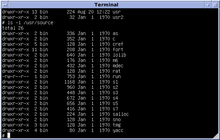Version 6 Unix
| Unixes by Bell |
|---|
| Research Unix |
| Other |
|
Sixth Edition Unix, also called Version 6 Unix or just V6, was the first version of the Unix operating system to see wide release outside Bell Labs. It was released in May 1975 and, like its direct predecessor, targeted the DEC PDP-11 family of minicomputers. It was superseded by Version 7 Unix in 1978/1979, although V6 systems remained in regular operation until at least 1985.[1]
AT&T Corporation licensed Version 5 Unix to educational institutions only, but licensed Version 6 also to commercial users for $20,000, and it remained the most widely used version into the 1980s.[2] An enhanced V6 was the basis of the first ever commercially sold Unix version, INTERACTIVE's IS/1. Bell's own PWB/UNIX 1.0 was also based on V6, where earlier (unreleased) versions were based on V4 and V5. Whitesmiths produced and marketed a (binary-compatible) V6 clone under the name Idris.
The code for the original V6 Unix has been made available under a BSD License under agreement from the SCO Group; see Ancient UNIX Systems.
Source code

Since source code was available and the license was not explicit enough to forbid it, V6 was taken up as a teaching tool, notably by the University of California, Berkeley, Johns Hopkins University and the University of New South Wales (UNSW).
UC Berkeley distributed a set of add-on programs called the First Berkeley Software Distribution or 1BSD, which later became a full-fledged operating system distribution.
UNSW professor John Lions' famous Commentary on UNIX 6th Edition was an edited selection of the main parts of the kernel as implemented for a Digital PDP-11/40, and was the main source of kernel documentation for many early Unix developers. Due to license restrictions on later Unix versions, the book was mainly distributed by samizdat photo-copying.
Portability
Interdata 7/32
In 1977, Richard Miller and Ross Nealon, working under the supervision of professor Juris Reinfelds at Wollongong University, completed a port of V6 Unix to the Interdata 7/32,[3][4] thus proving the portability of Unix and its new systems programming language C in practice. Their "Wollongong Interdata UNIX, Level 6" also included utilities developed at Wollongong, and later releases had features of V7, notably its C compiler. Wollongong Unix was the first ever port to a platform other than the PDP series of computers, proving that portable operating systems were indeed feasible, and that C was the language in which to write them. In 1980, this version was licensed to The Wollongong Group in Palo Alto that published it as Edition 7.
Interdata 8/32
Around the same time, a Bell Labs port to the Interdata 8/32 was completed, but not externally released. The goal of this port was to improve the portability of Unix more generally, as well to produce a portable version of the C compiler.[5] The resulting Portable C Compiler (PCC) was distributed with V7 and many later versions of Unix, and was used to produce the UNIX/32V port to the VAX.[6]
IBM VM/370
A third Unix portability project was completed at Princeton, N.J. in 1976–1977, where the Unix kernel was adapted to run as a guest operating on IBM's VM/370 virtualization environment.[5] This version became the nucleus of Amdahl's first internal UNIX offering. (see Amdahl UTS)
Variants and extensions
Bell Labs developed several variants of V6, including the stripped-down MINI-UNIX for low-end PDP-11 models, LSI-UNIX or LSX for the LSI-11, and the real-time operating system UNIX/RT, which merged V6 Unix and the earlier MERT hypervisor.[7]
After AT&T decided the distribution by Bell Labs of a number of pre-V7 bug fixes would constitute support (disallowed by an antitrust settlement) a tape with the patchset was slipped to Lou Katz of USENIX, who distributed them.[8]
The University of Sydney released the Australian Unix Share Accounting Method (AUSAM) in November 1979, a V6 variant with improved security and process accounting.
In the Eastern Bloc, clones of V6 Unix appeared for local-built PDP-11 clones (MNOS, later augmented for partial compatibility with BSD Unix) and for the Elektronika BK personal computer (BKUNIX, based on LSX).
V6 was used for teaching at MIT in 2002 through 2006, and subsequently replaced by an x86 clone called xv6.
External links
- V6 source code
- Wollongong Interdata UNIX source code
- Unix V6 Manuals - Web interface to the V6 manual pages.
- Unix V6 documents, e.g. C Reference, and man pages
- The First Unix Port; Richard Miller's account of porting Unix to the Interdata 7/32
- Unix V5, V6 and V7 for PDP-11 installed in SIMH emulator on MS Windows
- Unix v6 for PDP-11 online emulator
References
- ↑ Quarterman, John S.; Silberschatz, Abraham; Peterson, James L. (December 1985). "4.2BSD and 4.3BSD as examples of the Unix system". Computing Surveys. 17 (4): 379–418. CiteSeerX 10.1.1.117.9743
 . doi:10.1145/6041.6043.
. doi:10.1145/6041.6043. There are even some Version 6 systems still in regular operation.
- ↑ Fiedler, Ryan (October 1983). "The Unix Tutorial / Part 3: Unix in the Microcomputer Marketplace". BYTE. p. 132. Retrieved 30 January 2015.
- ↑ "The First Port of UNIX", Juris Reinfelds
- ↑ "The First Unix Port", Richard Miller
- 1 2 Johnson, S. C.; Ritchie, D. M. (1978). "Portability of C Programs and the UNIX System" (PDF). Bell System Tech. J. 57 (6): 2021–2048. doi:10.1002/j.1538-7305.1978.tb02141.x. Retrieved 16 December 2012.
- ↑ Thomas B. London; John F. Reiser (1978). "A Unix operating system for the DEC VAX-11/780 computer" (PDF).
- ↑ Bayer, D. L.; Lycklama, H. (1975). MERT - a multi-environment real-time operating system. Fifth ACM Symposium on Operating Systems Principles. Austin, TX. doi:10.1145/800213.806519.
- ↑ Toomey, Warren (December 2011). "The Strange Birth and Long Life of Unix". IEEE Spectrum. IEEE. Retrieved December 15, 2012.

